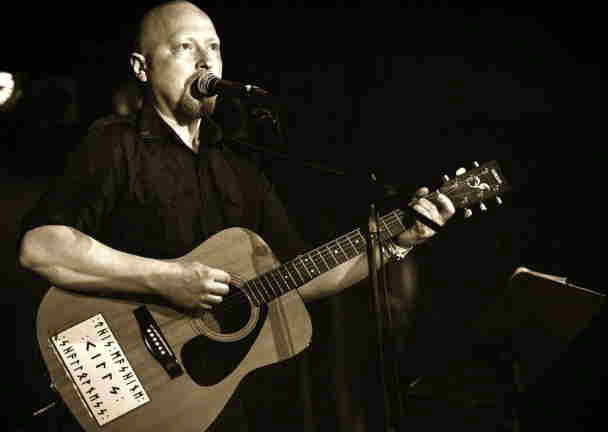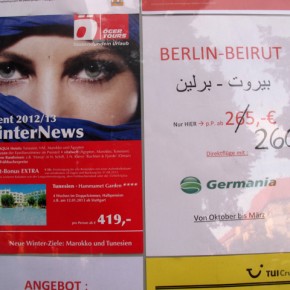Of the Wand & the Moon are one of the big guns of contemporary neofolk. Arriving a generation after founders like Death in June, Sol Invictus, and Current 93, Of the Wand & the Moon have breathed new life into this beautiful and perennially misunderstood genre. OTWATM’s 2011 The Lone Descent LP is widely regarded as a neofolk masterpiece. In a candid, in-depth conversation, singer and songwriter Kim Larsen spoke to Souciant about his music, and the controversy surrounding it.
First of all, a full disclosure: I’m extremely partial to a lot of music that falls under the “neofolk” banner. Most of the genre involves themes of bittersweet nostalgia, loss, unrequited love, and many other tropes that can also be found in traditional folk music. (Or, as I have taken to tongue-in-cheekishly calling older styles of folk now, “paleo-folk.”) As with Woody Guthrie’s opining about the beauty of the American wilderness, so many neofolk artists – a genre that is almost wholly dominated by European acts right now – can be found singing about lands that to the songwriters also hold some sort of magical and/or sentimental attachment. Themes of reconnecting with the past and mourning the loss of simpler times are common. (Granted, this is a common motif in conservative philosophy, too; but more on this later.) A surprisingly large amount of the songs, however, also deal with universal themes of love, death, depression, and separation. Sometimes historical metaphors are used; this type of allegory is common in the genre (see Rome’s “Querkraft” or Death in June’s “My Rhine Atrocity.”)
A common musical taxonomy holds that neofolk arrived as a bastard child of an overall “post-industrial” movement that began in the late 1970s and 1980s and which included bands and figures like NON/Boyd Rice, Genesis P-Orridge, Tony Wakeford, Current 93/David Tibet, Steven Stapleton/Nurse with Wound, and others. Death in June are also included in this mix although, unlike these other acts, Death in June’s roots lay directly in 3-chord political punk – specifically, the openly Trotskyite 1977 punk band Crisis. By 1980, members of Crisis had discovered Joy Division. This epiphany led ex-members Douglas Pearce, Tony Wakeford, and Patrick Leagas to start a band with a name as sketchy as Joy Division’s or New Order’s — Death in June. (According to one version of the story, “Death in June” refers to the purging of the SA and other Strasserite “left-Nazi” elements of the Nazi Party by Hitler on June 30, 1934; but singer Douglas Pearce has also said it’s a phrase he misheard that was uttered by bandmate Patrick Leagas.) Regardless, Death in June’s initial Joy Division-worship phase was eventually supplanted by a stripped down, acoustic guitar-driven folk-y sound that harkened back to 1960s folk music — albeit with a grim, postpunk sensibility. Although the band tended to employ black and white imagery from WWII history books, the music was strangely melancholic, even introspective – not at all the sort of aggressive rock music that such imagery was increasingly being used to signify at the time (see: Motorhead or other types of metal that were more and more using imagery of warfare.)
During an intense period of cross collaboration with the principle members of Current 93, Sol Invictus, and others, a sound was arrived at that was marked primarily by acoustic guitars and traditional, human-driven percussion with an array of other traditional, historic instruments. In the past, I have said the early neofolk ideal often seemed to be “Joy Division unplugged” – just think of Joy Division doing an MTV unplugged set while wearing militaria and banging on a kettle drum or two. In some ways, the neofolk of a song like Current 93’s “Ballad of the Pale Christ” appears as “next-level gothic music” – or perhaps simply truly gothic music, at last. Truly gothic, that is, in the sense that it seems eminently more traditional, and yet also simultaneously more innovative than much of the pap that was being called “gothic rock” around the same time period (1990s). Almost part-and-parcel with this musical development, which was primarily in England, was a strange fascination with the occult and Crowleyite mysticism on the one hand, and on the other hand with the uniforms and aesthetics of the Axis powers in World War II. This general aesthetic came to predominate in the early industrial and post-industrial scenes, sometimes ironically and sometimes quite simply to provoke, inflame, and confuse. Psychic TV, Current 93, and Death in June often led the charge in this area, although the nascent power electronics scene of groups like Whitehouse and Ramleh also indulged.
The imagery and visual motifs of neofolk have prompted a lot of suspicion, if not downright controversy. Generally, every band in the genre has its own rationale for the visual approach it takes, and I think it’s fair to say that there is no one sweeping vision that all follow in lockstep. I consider myself a student of the genre still, and by no means an expert — but my own experiences exploring this very rich milieu has so far led me to no other conclusion.
Unfortunately, although wearing military surplus gear has been a hallmark of the punk scene – at one point leading to accusations that Crass were a fascist band! — when neofolk bands do it, it raises eyebrows and evokes suspsicion. The band Die Weisse Rose, named after Sophie Scholl’s anti-Nazi organization, has been called fascist – because they wear armbands (with white flowers in them) and WWII-looking paramilitary uniforms. Generally, for every reason one can find as to why neofolk band X should be considered “a little dodgy” — and there are many people who spend an awful lot of time trying to find such reasons, to an obsessive degree that I have rarely seen in any other genre of music — there can be found some equally compelling reason that invalidates. (Which is not to say that some bands in the genre, as with some bands also in the genres of punk or metal, are not also odious, either.) For example, some people are still not sure how to process the fact that the sole remaining founder of Death in June, Douglas P., is gay, a vegetarian, has toured Israel under the Di6 moniker while brandishing Israeli flags on stage, and has cited Motown groups like the Supremes as among his chief influences. Similarly, although Boyd Rice is often cited as an especially dubious character, he’s generally presented himself as a cultural prankster – a real-life troll, that is, fucking with people – and who has owned a Tiki bar, fancies himself the true head of the Church of Satan, and has won several Jell-o mold championships (made in the form of Tiki/Polynesian idols), while recently singing in gay bear fetish videos. It’s strange to see some websites draw a hard and fast line when it comes to coverage of Boyd Rice or some other bands, yet continue to breezily run features on Burzum or Mayhem.
In any event, neofolk is now a sprawling, international enterprise. It is not any more ideologically driven as a musical genre than are genres like rock and roll or the blues. In other words, it is not essentially an advocate of political philosophy X, or metaphysical philosophy Y, or anything else. Some artists, like America’s King Dude, use the genre as a vehicle to play eerie, Appalachian style roots music. Belgium’s Militia explored the left-anarchist side of the Spanish Revolution in their LP The Black Flag Hoisted; Rome’s Flowers from Exile — one of the recent high watermarks of the genre alongside Of the Wand & the Moon’s The Lone Descent — is a kind of Romeo & Juliet love story about two people from Republican Spain and Fascist Italy falling in love with each other against all odds (members of singer Jerome Reuter’s family, in fact.) Sieben’s “Rite Against the Right” explicitly criticizes neo-fascist music fans; and there are so many other bands singing in such a multiplicity of languages that it’s hard to keep track of who thinks what.
Having said that, neofolk is not a hotbed of left-wing, anticapitalist protest music, either. Most musical genres are not. I’ve noted before, and with displeasure, a certain tendency I have encountered again and again — coming mostly from folks who have a grounding in the same DIY hardcore punk scene I was raised in — to want to see music as teleological. That is, it must have some clear and definite social purpose. Preferably, this will come in the form of a given song or band being pro-this, or pro-that. In this worldview, songs are much like positions papers, either advocating something definite, or opposing it. This has never been how music (or art in general) has worked. Generally it has been about self-expression — perhaps with coincidental advocacy. Not every painter is Diego Rivera. Many are Impressionists.
Shifting out of this doctrinaire mindset, which is the norm in punk, and being able to take neofolk on its own merits — divorced from any attempt to try to artificially proscribe motives onto the music — can be hard for some. So, a use of runes must mean some sort of tacit avowal or approval of all the worst groups or political organizations that have ever used similar runic symbols. There is an ideological view of art as a cultural force that should promote a political agenda. This view will not gel easily with the much more self-contained and generally non-political world of neofolk. In general — and, yes, there are exceptions, as with everything — neofolk is more about capturing emotion, feeling, and what could be called “the spiritual,” and in a truly traditional Romantic sense, than it is in providing any sort of cultural heft to promoting a party platform. This is the broad impression I have always had of neofolk. It necessarily does not account for every single band.
Of the Wand & the Moon are one of the clearest examples of this. Most of the Danish band’s songs are achingly solemn songs that a writer like Edgar Allan Poe or Charles Baudelaire could have admired . Led by Kim Larsen, the band fittingly employs a traditionalist, Romantic iconography to paint devastating portraits of irreconcilable loss, love, and death. It’s as simple, and as complicated, as that.

AN INTERVIEW WITH KIM LARSEN
Conducted November 26, 2012. Special thanks to Megan Keith for clarification on the “This Machine Kills….” sign on Kim’s guitar. This interview is dedicated to SK.
Souciant: What significance does the “life rune”/algiz symbol/Ψ have for you? Several other neofolk bands have used this rune, but it’s used to a greater degree in all of OTWATM’s material than almost any other band. It’s almost the personal logo of the band at this point. What do you see as the algiz’s meaning for you?
Kim Larsen: I guess the first thing I noticed about the Algiz rune was its powerful appearance and of course magickal, and to some extent historic, meaning and influence. I am not going to go into magick talk here; there are others more qualified than me to talk about these issues. Also, I think it is necessary for people to discover these things on their own to get the full enjoyment out of it — if they should wish to do so.
However, it was actually some time after I did the ‘burning Algiz branch’ photos for the :Emptiness:Emptiness:Emptiness: album that I realized that I could make a bind rune of the letters “KIM” with the “Algiz” in the younger futhark. It was a revelation that struck me on a very personal level. Somehow it made deeper sense to me why I went to Sweden for this particular place with this particular imagery in mind. At the time I just wanted to do it for the visual aesthetic and of course also the significance of that place.
Souciant: The psychedelic influence in OTWATM’s work seems to have reached some sort of culmination in The Lone Descent LP. Songs like “We Are Dust” and “A Tomb of Seasoned Dye” are extremely psychedelic. Has psychedelic music been an influence on you for awhile, or is this a newfound interest of yours….? I remember Death in June’s Rule of Thirds LP was compared to Syd Barrett by some — so maybe there is more psychedelia in neofolk than some are willing to acknowledge?
Kim Larsen:I guess there has always been a psychedelic influence as you put it in neofolk. Or maybe an inspiration from the 60s. I hear it in Scorpion Wind, for instance, and the Ennio Morricone influence in Death In June’s earlier stuff. I guess there are other links with other acts.
I find it very natural to include these 1960s sounds in OTWATM. As a kid I listened to a lot of my father’s records. Like a Beatles album such as With The Beatles, which has that mono sixties sound. Another one I remember was the Serge Gainsbourg/Jane Birkin “Je T’aime” 7” with that ‘plonkety’ ’60s bass. I took over those albums from my father and still have them. It is of course not until later that I realized this was an ‘influence’ at all. But I guess what you hear as a child has a big impact on you.
Anyway, the 1960s/Merseybeat/Wall of Sound is a huge influence, too.
Souciant: As well, I wonder if you could make any comments about the relation of OTWATM’s relation to traditional folk music — what I sometimes call “Paleofolk.” I know you have done a Lee Hazlewood cover, and once on your guitar you painted “This Machine Kills Shallowness,” maybe an homage to American folk singer Woody Guthrie. Are musicians like Woody Guthrie or Lee Hazlewood important influences on OTWATM?
Kim Larsen: Lee Hazlewood has certainly also been an influence. Again, that sixties sound and the dark pop songs. Woody hasn’t been an influence apart from the guitar paint slogan. I liked the idea and the imagery of his “This Machine Kills Fascism” label on his guitar. I adapted it on different occasions with “This Machine Kills Politics” and “Politics are for people who can’t run their own lives.”
Souciant: I’ve come across a few sites in German that try to say Of the Wand & the Moon are a fascist band. I can’t read German, but I can see from the pictures what they are getting at. Most of your songs, however, to me, seem to be very personal, intimate songs about loss, remembrance, and heartbreak. “Lost in Emptiness” and a song like “Immer Vorwarts” seem like personal recollections about love. There’s nothing political in much of anything I see by OTWATM. So, how do you answer the charges that OTWATM are crypto-fascist? Do you have any thoughts about how these accusations continually recur for many of the bands working in the same milieu as you?
Kim Larsen: You are quite right, there is no political motivation behind my music. I couldn’t think of anything more boring than politics. Well, maybe sports…
I remember the (German website,) and that incident. The thing is with these anonymous people, that they have already made their minds up about you when they try to get your shows cancelled. They never contact you first to hear what you are about. And when you answer them, after they have stirred up things, explaining “I am not a fascist, I am not a racist, I am not a Nazi,” their usual reply is, “Oh well, we never called you a Nazi; however, it is problematic that you use runes, etc.” – and on, and on, and on, and on. I guess in order not to loose face or not to get sued for using the N word — “Nazi” — against you. Luckily this thing has happened very few times in the years I have done my OTWATM project.
In September 2012, however, the Honig Fabrik venue in Hamburg choosing to cancel an OTWATM show 1 or 2 weeks before we were supposed to play. Again without prior contact with me personally. And again after telling where I stand they changed their statement from “OTWATM hasn’t taken a stand against these issues, etc.,” to “Well, we are not calling OTWATM Nazis, but it is problematic that they are playing with right wing bands.” And again: What, actual right wing bands? (They are never mentioned by name.) I have not played with any right wing bands.
I guess this is the first time I am really talking about this whole issue, and to be honest I don’t like to waste too much time with it. I guess it will be the same talk 10 years from now, but maybe people also need to know how these things work. Recently there have also been problems of this sort for the Runes & Men Festival in Dresden. Here, as opposed to the Honig Fabrik in Hamburg, the venue Reithalle Strasse E showed some balls and made this statement :
https://www.facebook.com/Reithalle/posts/488131831226964
If you don’t read German, the Google translate makes a fairly readable English translation…
Souciant: Are you at work on new Of the Wand & the Moon material now? Will it follow the psychedelic trajectory that was hinted at in The Lone Descent, or do you think a different change of direction is in store for the band? Can you give us a hint at what OTWATM might be sounding like on their next LP — ? What themes or sounds are you exploring?
Kim Larsen: I really haven’t done much new material for OTWATM. The Lone Descent was a very time consuming piece of work and I still feel very drained after this. I’m working more on other projects at the moment to get a bit of distance and a build up of new energy. You see, I am not a person who wants to put out an album each year that I don’t feel is 100% and that sounds like the previous, just to make money of this. There are enough people doing that.
Souciant: Although you’re from Denmark, a lot if not all of your song lyrics are in English. This is good for folks like me in America, but some other neofolk bands like Darkwood rarely sing in English. Was this a conscious decision, and what is the reason for it?
Kim Larsen: In the very beginning I was talking with a singer of doing the singing in old Norse. But I felt we weren’t totally in tune and I was very specific in what direction I wanted OTWATM to go, so I did the lyrics and vocals myself. I did do some old Norse lyrics for the first albums, to express some authenticity in some ways I guess.
However, I never felt comfortable with singing in my native tongue. Not sure why, but it always sounded strange to me.
There were also a revival of some sort here in Denmark where a lot of bands were singing in Danish. A trend that made me even more reluctant to sing in Danish. Germans have a history of speaking only German so somehow makes sense for them.
Souciant: Here’s a pretty basic question: What is the story behind the name “Of the Wand & the Moon”? What does it mean?
Kim Larsen: The first works of OTWATM revolved a lot around magick, and the Wand represents the magickal aspect of the music while the Moon represents the inspiration of the night. I often work on the music in the night-time.
Souciant: And about the song “Immer Vorwärts.” It’s an especially beautiful song to me, something that’s become associated in my mind with a certain person and a certain place. What’s the song about? Can you spill the beans about whom you might be singing on that track?
Kim Larsen: Yes, “Immer Vorwärts’ was written about a specific person. Kind of personal, if you know what I mean…
Souciant: You originally have roots in the doom metal scene. Do you ever feel compelled to go back to that scene or to start another project that would revisit your own origins in metal?
Kim Larsen: I actually did with the funeral doom project Black Wreath, with the album ‘A Pyre Of Lost Dreams’ that was released in 2009. Some of the music dated all the way back from when I was doing music for my first band Saturnus, so….
Black Wreath was meant as a studio project but we have had some offers to play live, so maybe 2013 will see a live manifestation if I can find time for this.
Souciant: What are your personal, religious beliefs, and how do they inform your music? References to Lucifer abound in your work – especially the earlier OTWATM material. I know there’s a tradition of Lucifer as representative of wisdom, a revealer of knowledge, a light in the dark, etc. Is this any sort of tradition you find meaningful, and is your faith, in fact, a type of Satanism or Luciferianism?
Kim Larsen I don’t have any religious beliefs. The only truths to me are that ‘We Are Dust’ and ‘Everything Must Pass’. The Lucifer thing…well…
The name of my 3rd album, ‘Lucifer,’ came out of the song of the same name and the fact I was experiencing some censorship from the German magazine Sonic Seducer, due to more right-wing accusations…. So, it seems this interview is going to be where Kim finally spills his guts! Hahaha!
I figured if I was getting some left-wing persons pissed off so easily, then I might also get some Christians pissed off with the “Lucifer” title. No luck with the Christians, though! Just to point out how ridiculous these censorship things can get I remember them (Sonic Seducer = SS, by the way) accusing me of standing in front of a WW2 concentration camp chimney on the cover of my album :Emptiness:Emptiness:Emptiness:. Well, if they bothered to look — it was a rune stone in Sweden!
As well, the only song they had of mine was from their own sampler of their magazine some years before (when there were no problems between us). It was the song “Raven Chant.” They had translated the opening lyrics as “True concentration camps” where in fact I am singing “True consecration comes….” When I confronted them with this, the reply was, “Well, you are trying to make it sound like True Concentration Camps.”
I rest my case.

Souciant: Aside from anything related to OTWATM, is there any political philosophy that you find persuasive, or that appeals to you on a personal basis? What political philosophy is it, and why?
Kim Larsen: As I said previously, I find nothing more boring than politics, be they right-wing, left-wing, or whatever. And I won’t have my music smudged with any of it. Besides, I wouldn’t join a club that would have the likes of me as member, to quote Groucho Marx.
Souciant: The American neofolk scene is pretty diffuse — it’s spread further apart, culturally and geographically, than the scene in Europe, which seems comparatively tighter-knit. Are there any American neofolk bands you find especially noteworthy? As I’m sure you know, the biggest band here now is probably Cult of Youth, who have combined neofolk with a kind of punk sensibility .. but there are also a few bands like Wreathes that seem more “European” to me. Are there any US bands you like a lot and what do you think of the idea of neofolk in America anyway?
Kim Larsen: I haven’t heard Wreathes to be honest, but Cult of Youth seems to go their own way which is commendable. So does King Dude, and that I like very much. In the psychedelic folk end there is Novemthree and Arrowwood. Been a while since I checked out what they have been up to. We worked together on my Solanaceae album. Of course there is also a band like Blood Axis that I enjoy. Seems the American bands go their own way, which is great. Must admit I can get a little bit tired of the monotony of the European neofolk stuff these days.
Souciant: Any chance you will play American any time soon?
Kim Larsen: I have been asked several times and plans have been made, but every time it didn’t come through. There are also talks at the moment for 2013 but guess time will tell. Personally I would love to see the US again though…
Souciant: Thanks so much for your time, Kim!
Kim Larsen: Thank you for your time as well, Oliver.
Photo of Kim Larsen used with by permission by Kim Larsen. All rights reserved.






1 comment